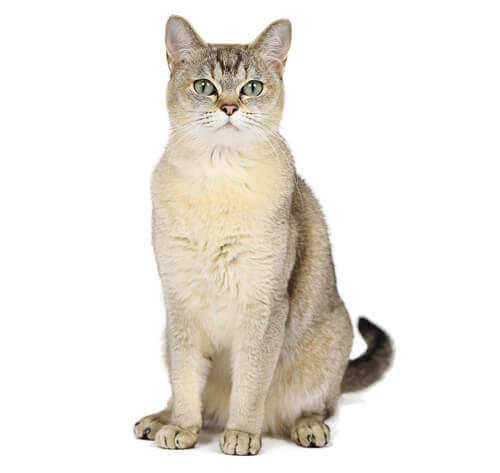
The Burmilla cat breed is of medium build, similar to Burmese cats, with a sturdy, well muscled body and a strong straight back. The female is much smaller and daintier than the male. The head has a gently rounded dome, a wedge shaped muzzle and wide set ears. The expressive eyes may be any colour from gold through to green. The coat is short and close lying with a pale undercoat and even 'tipping' (darker colour at the tip of the hairs) over the rest of the body and a distinct 'M' marking on the forehead.
The need-to-know
- Playful and curious cat
- Friendly but independent cat
- Somehow talkative cat
- Average build cat breed
- Requires grooming once a week
- Needs some out-door space
- Great family cat
Personality

There are no specific conditions relating to Asians in the veterinary literature, however, there may be a tendency for this group to develop conditions associated with the Burmese. Some lines of this breed appear to be more susceptible to diabetes mellitus than other breeds.
History and Origins

Country of Origin: Britain
The Burmilla cat is a shorthaired member of the Asian cat breed group. The breed was created in 1981 by an accidental mating between a male Chinchilla cat and a lilac female Burmese cat. The kittens looked and behaved like a Burmese cats but they had the stunning silver colouring and the tipped markings of the Chinchilla cat breed. In fact, so much interest was generated that the pair were allowed to mate again, and from there a new breed was formed.
Nutrition and Feeding

Every cat is unique and each has their own particular likes, dislikes, and needs when it comes to food. However, cats are carnivores and every cat must obtain 41 different and specific nutrients from their food. The proportion of these nutrients will vary depending on age, lifestyle and overall health, so it's not surprising that a growing, energetic kitten needs a different balance of nutrients in her diet than a less active senior cat. Other considerations to bear in mind are feeding the right quantity of food to maintain 'ideal body condition' in accordance with feeding guidelines and catering to individual preference regarding wet or dry food recipes.
Other Information

Health and common issues
There are no specific conditions relating to Asians in the veterinary literature, however, there may be a tendency for this group to develop conditions associated with the Burmese. Some lines of this breed appear to be more susceptible to diabetes mellitus than other breeds.
Best cat breeds for children
While this breed is not widely recognised as one of the best breeds for children, all cats are different and with the proper familiarisation may still be able to live with children.